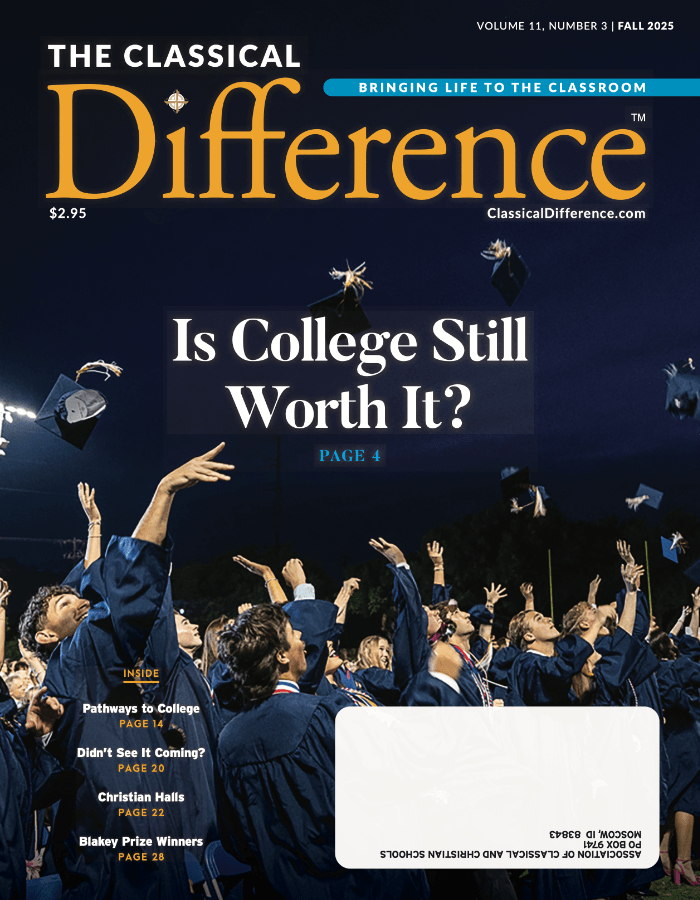Art and Christianity Are Eternal
Ars longa; vita brevis. “Art is long, life is brief.” This phrase is attributed to the fourth century Roman statesman, Seneca, but it is believed to have originated first with Hippocrates, who spoke to this human dilemma in the opening pages of his medical text Aphorisma. Seneca’s Latin reverses Hippocrates’s Greek aphorism, vita brevis; ars longa or “life is short; art is eternal.” Hippocrates, of course, did not intend these words to become the angst-song for postmodern struggling artists. For Hippocrates, art was craft or, literally, “technique.” His art was his vocation. Hippocrates was practical, but he was no pragmatic; work was artful living given toward skillful labor in medicine. Seeking to articulate the tension of being a mortal man pursuing dominion over a vast realm of creation, he spoke poetically, proverbially: “Life is brief; art is long.”
We can relate can’t we? Consider my vocations as mother and teacher. These ancient vocations require daily practical wisdom as well as the ability to continually see each child’s glory self. We have limited time; we have much to learn. I believe this is where the ancients help us. Their understanding of art as craft, and craft as vocation, is infinitely closer to the biblical concept of “art” than that which is commonly understood today. Gene Edward Veith notes in State of the Arts that art as merely wall hangings in a museum would have been utterly foreign to ancients such as Hippocrates and Seneca, to the Hebrews…to most people in most other cultures throughout time.
More than a Subject
Except for us moderns. This is because, even as Christians, we are children of the Enlightenment, which is shorthand for saying we compartmentalize, specialize, mechanize, and rationalize everything, to the extent that what was once a gigantic culture-force (one’s art is one’s vocation) we have shrunk to a three letter word. Art. We take a field trip to see “it” once a year in a local museum. If we listen to ourselves we will hear this world-view shift. I teach grammar and logic students visual art and art history. Every parent to whom I speak about their children’s artwork assures me he himself is “not an artist.” Writers have told me this. Attorneys. Photographers. IT specialists. Nurses. Entrepreneurs. Mothers. Percussionists. Pastors.
The Christian world view, the Bible itself, however, tells us something very different, something true which should be shaping us in our vocations, and which should be undergirding and molding our culture more and more towards Christ’s kingdom-imperatives. As Christians, parents, and educators, we would do well to recover the biblical definition of art and the import of this definition for Christian living. Scripture’s artful thrust serves as a useful meditation for me each week as I guide students through contour drawing, painting fundamentals, and Giotto’s The Resurrection of Lazarus. Since one of our goals as a Christian school is for our students to take every thought captive to Christ, applying Scripture to our weekly art studies makes fine art endeavors life endeavors. Rooting fine art study into Scripture’s teaching about art and artists gives students more than skill in draftsmanship. They gain skill in Christian living. Have you ever thought of Art class as a course in Christian discipleship?
Art is Worship
How, then, do we translate learning to draw skillfully into learning to live skillfully? We begin at the beginning. The biblical antithesis to worldly pragmatism is the imago dei – man is made in the image of God. Truly, we cannot too much impress this truth upon our children. Every subliminal message in our culture today, and every overt one, tells them otherwise. Art students are makers in God’s image and they are God’s workmanship.
While Scripture gives us unfathomable depths of instruction about art and God’s kingdom, the key to an artful life is an obedient one. Looking to Jesus Christ we find in Him the fullness and embodiment of all Scripture’s teaching along these lines. Thus, last year for my Art classes, I identified one penetrating reality of Jesus’s Incarnation, of His Personhood, and set it before us as an immersive mindset: There is victory in the striving.
Jesus put on skin like our skin, which is to say He stepped into our striving. He stepped into our art and he stepped into our mortality. Thus, contrary to entrenched Enlightenment thinking, cultivating one’s art under the strain of one’s mortality is a glory. The tension we feel, the obstacles we must overcome, are good. In Jesus we find not only true humanity and the true Artist, but also the principles young makers need for growing more like Christ. Learning how to strive in Christ, like Christ, is fundamental to living as redeemed creatures in the New Humanity. Even third graders need to hear this.
Redeemed Work
Jesus referred to himself most often as The Son of Man. Showing us there is no inherent sin in the striving, He put up a good fight. Jesus threw down Satan in the wilderness long before He crushed this enemy’s head at the cross. His ultimate victory came through a process of striving, a process of obedience, a process Jesus sanctified for His people. Jesus learned to tame wood. He trained his singing voice. Meekly He sat at the feet of temple teachers. He obeyed His parents. We often emphasize the thorns and thistles of labor under the curse of the fall: “Work is hard because we’re fallen.” But the Second Adam tells us something equally true; in Christ our work is redeemed. Thus, it is not inherently sinful to struggle inside the constraints of time and space, and limited skill, as we glorify God with the work of our hands. Moreover, it is not bestial. Striving in Christ is not spiritualized survival of the fittest.
This concept of biblical striving is painfully challenging for modern students to grasp, in large part, I think, because it is painful for us all. Art students who are perfectionistic equate with failure stray lines and the need for an eraser. More indifferent students see a blank canvas before them and jettison the necessary effort required: “I’m not an artist either.” Those who are accustomed to immediate gratification twitch and squirm when told a drawing project will take four weeks to complete. (Copying a portrait of Shakespeare takes longer than microwaving popcorn.) Still others must let go the sinful tendency to judge themselves and their work by that which they perceive is more clever or skillful work by their neighbor. They must resist envy and despair. All these students must grow more comfortable in their own “art skin.” Art is long, and it is, as Elizabeth Elliot says of the Christian life, “a long obedience in the same direction.” This is Christian training. This is vocational training. And the only way to do this, the only way to overcome in Art class, is through the gospel.
An Easy Yoke and a Light Burden
What good news is the gospel to mortal art students! The perfectionistic student can learn to embrace Christ’s perfections. Jesus’s active obedience applies to this student’s stray line and her need for an eraser. Christ did everything perfectly for her. So breathe! Enjoy making adjustments. There is more than victory in the striving; there is freedom in Christ’s spotless, sinless learning. The half-hearted, fearful student can also learn to embrace all that is theirs in Christ’s humanity. This student must see that learning — tackling something new, unfamiliar, and difficult — is a dignity. Jesus likely obeyed the laws of skillful carpentry just as He obeyed and fulfilled God’s moral law to the point of death.
Mysteriously, Jesus took on learning as a human endeavor, which means students grow more like their Savior as they embrace a new challenge. Students asked to cheerfully labor through a four-week drawing project are actually being trained in the process of sanctification. We don’t get from Here to There as quick as a game of Angry Birds. In many ways, making visual art does imitate life; meekly submitting to instruction, correction, and guidance in the end produces recognizably beautiful fruit. What about the student who burns jealous every time she glimpses her neighbor’s composition? The gospel is freedom for her, too. Learning to be content in one’s own art skin, enjoying the satisfaction of one’s own labors under the sun, requires embracing the imago dei. We celebrate God’s fingerprint on each student. He gave each one individuality, a unique drawing hand, a developing style. So shake it off. Paint it up!
Biblical Life is Artful
Ultimately, the Bible teaches an artful life is an obedient one. Where there is obedience to Christ there is victory in the striving even as there is victory in the end prize. We tend to think victory is the trophy. Victory is heaven. Victory is the touchdown at the end of a pass, or the deal sealed, or the court case won, or the money made. While all this is true, the Bible gives us a fuller theology of victory. Noah was victorious every moment he obeyed God in faithful boat-building. Jesus was victorious inside our humanity and He took his humanity with him into forever.
This is a far cry from a life given to the rat race. Contrarily, biblical striving reveals the dignity of our God-bestowed humanity. Ours is a counter contest where laughter and joy triumph, where all is vanity and so we work really hard (Ecclesiastes). This is a blessed glory because the truth is, for Christians, art is long and life is eternal. This is important for all of us to “put on” for we are sojourners in a strange pragmatic land. And our art, our vocation, is to lead our children toward eternity as they concurrently learn to draw and learn to live.
Alane Holm is married to Jason, an artful supply chain analyst. She formerly taught students visual art and Bible at Agape Christi Academy in Eden Prairie, MN. Holding a B.A. in English, she has studied theology and culture through courses at Reformed Theological Seminary. As for her art, her four children, and her students, are her letter.










